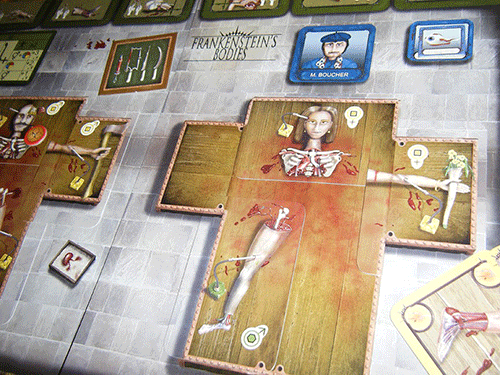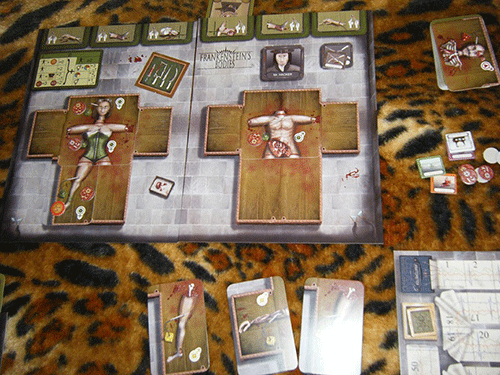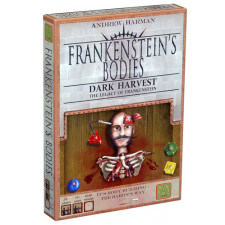Frankenstein's Bodies Review
on Oct 12, 2016
The Boris Karloff version of Frankenstein's monster is not very articulate, his vocabulary to various versions of "Graah!" But the sometimes-protagonist of Mary Shelley's novel is not only well-spoken but well-read, fully capable of outwitting its creator.

The leg bone's connected to...well...nothing yet, but we'll get there.
Frankenstein's Bodies, self-published by Andrew Harman and YAY Games, is more like the former. The only words it knows are "Take That!" Like Dr. Frankenstein's creation, the game is dull, derivative, and obnoxiously spiteful.
Set in the RPG world of Dark Harvest, in which Victor Frankenstein's experiments changed the face of European politics, Frankenstein's Bodies is a simple-by-design competitive body-building game for 2-6 mad scientists. It's essentially a single-deck card game with a bunch of extra parts that don't serve much function except to create bulk. Digging through the deck for body parts or stealing them from one another's lab benches, players compete to assemble the most complete and symmetrical corpses for the doctor to reanimate.
The problem is that there just aren't enough parts to go around (when playing with fewer players, I highly recommend the "Mean" and "Nasty" variants buried at the back of the rules). After the first pass through the deck, they're all out on the table or discarded in the body pit, which means that the only way to complete your own creation is to play a "surgery" card, swiping a body part from an opponent and dragging it back to your own lab in the dead of night. You can also use these cards to "donate" unwanted or incongruous parts to your rivals.
This non-elective surgery makes up the majority of play, turning it into a game of "musical torso." Luckily, there are a few ways to protect your assets, such as allowing infections to fester: any body parts that move between labs get infected, and infected body parts can't be surgerized. This isn't a great long-term strategy, though, since infected parts also don't score, and your opponents can always spritz some carbolic acid on the desired limb before carting it off. A more long-term solution is to hire a master surgeon versed in Frankenstein's 3 P's: preventing infection, protecting the part from competing interests, and scoring bonus points. As with surgery, master surgeons can be forcibly "relocated" by playing the right card.

The only fun part of the game is watching the bodies come together.
The protection part alone would have been powerful, but when you add in the scoring bonus and infection-prevention, master surgeons are ridiculously overpowered, giving the game a strong sense of luck-of-the-draw. The only thing mitigating this somewhat is the "daily delivery," an open auction/card draft from which each player may pick one card per round. However, it's just not enough, and a player who gets first pick or blind draws several master surgeons merely needs to snipe any "relocate a master surgeon" cards that come out of the deck, and she is practically guaranteed victory.
There's a third way to avoid malicious card play, and that's by playing a redirect or "Not in my lab!" card. When targeted by any other card, a player can throw one of these down to choose a new target for the attack—which can include the player who originated the action. Being forced to reassign one of your own surgeons or body parts is at least an original mechanic. At the same time, these redirects merely provide more protection for players who've won the master surgeon lottery.
Unlike the nine-foot-tall green guy with stitchmarks all over his face, Frankenstein's Bodies just doesn't stand out in a crowd. Even the theming fails to capture the originality of the RPG setting—there's nothing setting this apart from a game like It's Alive! The overlapping body part cards, give a good visual progression from exposed bones and viscera to something that actually resembles stitched-together corpses, but it's also fiddly as hell, especially considering how often the parts change hands, and it can be very difficult to read if someone across the table isn't keeping up all the tucking and aligning. It's a by-the-numbers Take That! card game that, like a revitalized corpse, has nothing new to offer the world.

 Customer Support
Customer Support  Subscribe
Subscribe 




 Account
Account  Wishlist
Wishlist 

